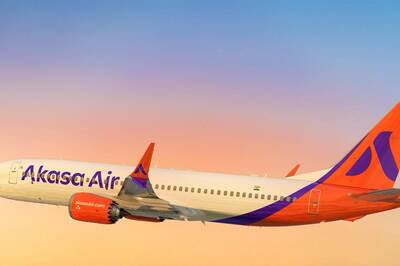
views
In a significant development that promises to take India’s logistical capabilities to the next level, the Indian Railways has fully completed construction on the Eastern Dedicated Freight Corridor (EDFC). Today, the entire 1,337 km stretch of the EDFC, from Ludhiana to Sonnagar, is functional and is being used by the Indian Railways. Simultaneously, the Western Dedicated Freight Corridor is also swiftly moving towards completion, with work on 1,176 km out of 1,506 km of WDFC already having been completed. Effectively, work on 88% of the Dedicated Freight Corridor is now complete.
To supplement the Dedicated Freight Corridor, the government is also developing Gati Shakti Cargo Terminals (GCTs) across the country. These are multimodal logistics facilities that can handle rail cargo along with other modes such as road or water transport. As of June 2023, the government had commissioned 48 GCTs. In the next three financial years, it hopes to commission 100 GCTs. Interestingly, the private sector is leading the charge to develop such terminals, under the ambitious ‘Gati Shakti Multimodal Cargo Terminal (GCT)’ policy.
The Dedicated Freight Corridor (DFC) was given the go-ahead by the Union Cabinet in 2006. After 18 years, this corridor is only now nearing completion. What was supposed to initially cost Rs 28,000 crore has ended up costing India over Rs 1.4 lakh crore. Despite the many challenges and a rather significant cost overrun, the importance of the entire DFC project finally nearing completion cannot be stated enough.
Why DFC is crucial
India has set a goal for itself. It wants to become a global manufacturing hub. However, that cannot be achieved unless India sets up robust end-to-end logistics chains that cut down on transit time and ensure seamless movement of goods – all while remaining the most cost-effective mode of transportation. India realises that the future of transporting goods and commodities is tied to intricate freight rail corridors – which is why the DFC has assumed such importance.
On an average day, around 140 trains carrying coal and steel now ply the Eastern Dedicated Freight Corridor (EDFC). The other portion – the Western Dedicated Freight Corridor – runs almost parallel to the western arm of the Golden Quadrilateral.
The ultimate goal is to connect the EDFC and WDFC with coastal freight corridors that are to come up in central and southern India. In lieu of this, the Indian Railways’ special purpose vehicle, DFCCIL is working on detailed project reports to connect the entire country with railway corridors. The DFC itself is no ordinary project. It covers nine states, spans 77 districts, and involves approximately 11,000 hectares of land acquisition.
There’s more. In a recent study, the Railway Board has stressed the importance of dedicated coal corridors to meet the increasing power demand in India. The report has estimated that coal transportation by rail will play a crucial role in ensuring India’s power security in the near future. So, it has called for the alignment of coal corridors with dedicated freight corridors (DFC).
Last year, Prime Minister Narendra Modi launched ‘The National Logistics Policy’ intending to halve the current cost of transporting India-made goods internally and to the world by 2030. Logistics costs in India are 16% compared to 10% in China. Speaking of logistics, railways are about 12 times more efficient in freight traffic. Also, rail-based freight movement is more environmentally friendly.
Here are some interesting numbers:
- According to the National Rail Plan (NRP) 2020, the goal is to increase the modal share of rail to 40%-45% of the logistics market to move 3,600 million tonnes (MT) of cargo by 2030-31.
- Rail freight costs the least at Rs 1.6 per tonne kilometre, making railways one of the cheapest modes of transporting goods and commodities.
- In FY 2022-23, Indian Railways recorded the best-ever performance in its recorded history in terms of the output from the freight business in the financial year 2022-23 with an originating freight loading of 1512 MT.
Railways were once the go-to mode of transporting goods and commodities in India. However, as the quality and network of highways improved and India’s aviation sector took off, railways fell behind. From 86.2% in 1951 to 27% today, the fall in railways’ share of freight movement has been drastic. Dedicated Freight Corridor Corporation of India (DFCCI) proposes to reclaim the railway’s share in freight traffic by running faster, heavier, higher, and longer trains on the upcoming corridors.
DFC: A boon for India
The Dedicated Freight Corridor, once fully operational, will prove to be a boon for India. Remember, a majority of freight trains run on common rail lines with the passenger trains. This has led to a lot of traffic on these rail routes, and preference is always given to passenger trains first. This means freight trains are made to wait – something which should not be the case in a fast-growing economy and developing country such as ours.
For example, as of now, freight trains from Mumbai take three days to reach Delhi. Once all sections of the DFC are complete, the duration will be reduced to 48 hours and there will be a continuous flow of freight trains. The average speed of freight trains is 20 to 25 km per hour as of now. Once the DFC is complete, the average speed will increase to over 60 km per hour!
The end goal is to move a majority of freight trains on the DFC and associated freight corridors. This will greatly reduce the travel time for freight trains on dedicated corridors, and also clear up traffic out of passenger rail routes. That will, in turn, provide a much-needed impetus to India’s growth trajectory and logistics sector, while also boosting India’s manufacturing sector and its ability to transport goods. Once logistical challenges ease, the manufacturing sector will more confidently play its role in nation-building.
Removing hurdles
However, India must learn from the mistakes made during the construction of the Dedicated Freight Corridor. First, the need for approvals from every department that exists must be eliminated. Bureaucratic red-tapism can no longer be tolerated in a country like ours that aspires to be the 3rd largest economy soon – and a developed nation by 2047.
Land acquisition must be expedited for all such projects of national importance. The government must ensure that the land on which national infrastructure is to be built is made readily available. Also, the PM Gati Shakti initiative must be made complementary to all projects of national importance – like the creation of dedicated freight corridors. The constant shifting of utility services – whether they be underground pipelines, electricity polls, network transmission lines, sewage lines, or others – must be done away with. A strategic and foolproof plan is needed so that dedicated freight corridors can be implemented without any hassle.
Finally, the dedicated freight corridors must also comprise private or public partners that make an end-to-end logistical chain. This is one advantage of road transport. Goods and commodities can reach the very final destination – unlike freight trains – which have to be terminated at select points that might still be away from the destination. This also leads to a net hike in logistical tariffs for those using freight train services, as they ultimately end up employing the services of trucks and containers anyway. The government must think along strategic lines and make sure the logistical chain is made complete.
Only if we overcome these challenges can India boast of a beast-like logistics network that truly represents the might of our country and does justice to its growth aspirations and future needs.


















Comments
0 comment